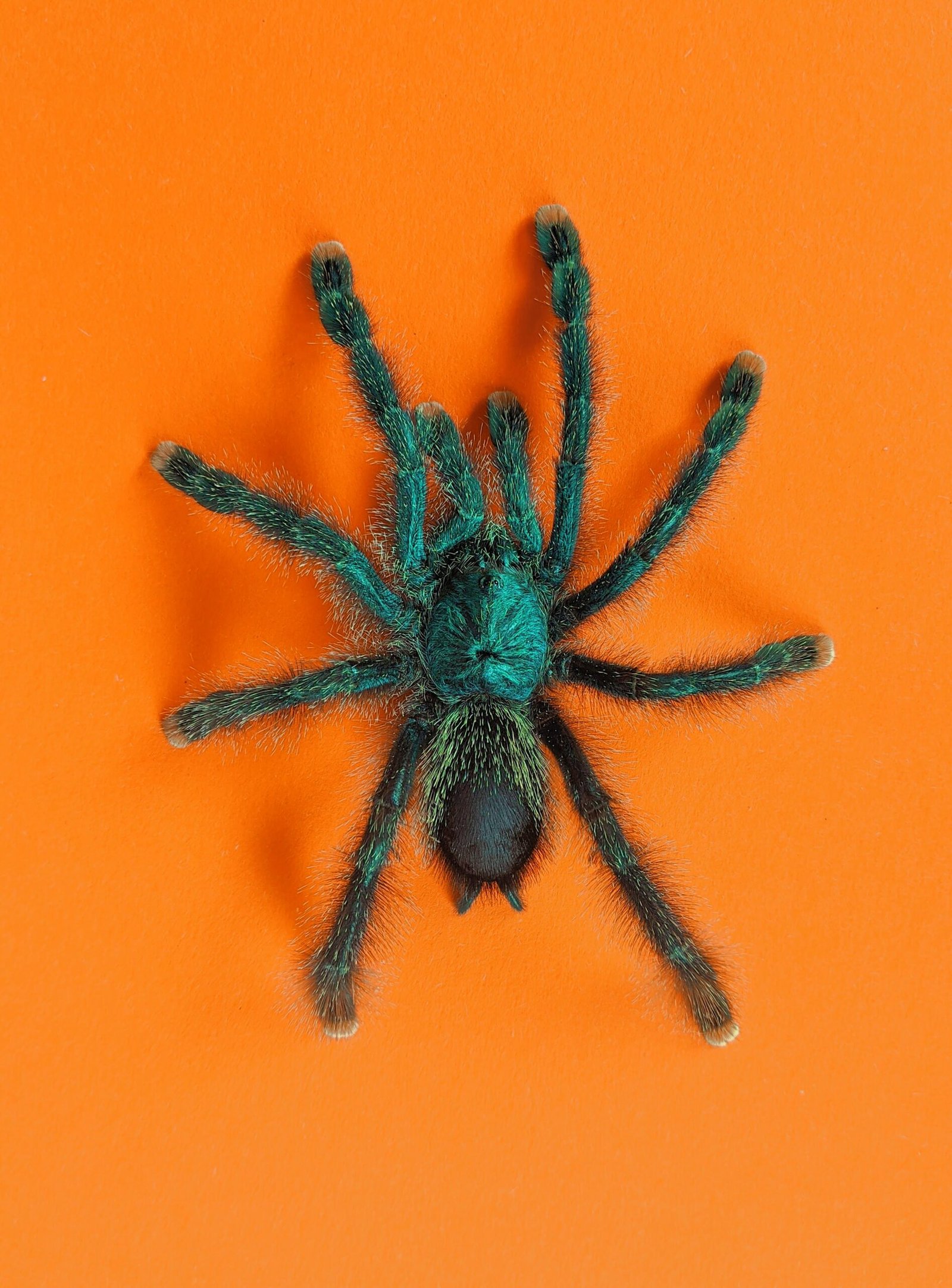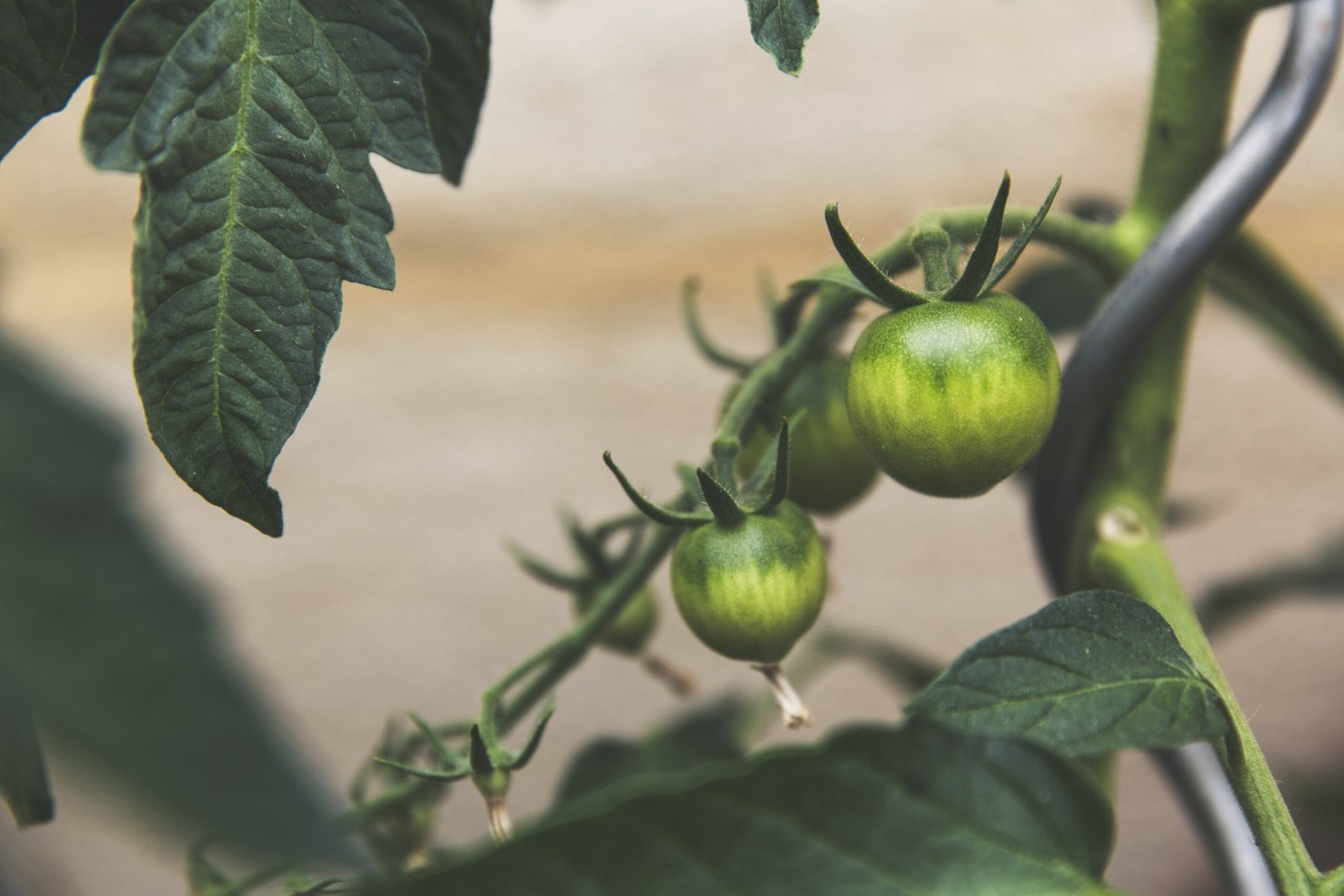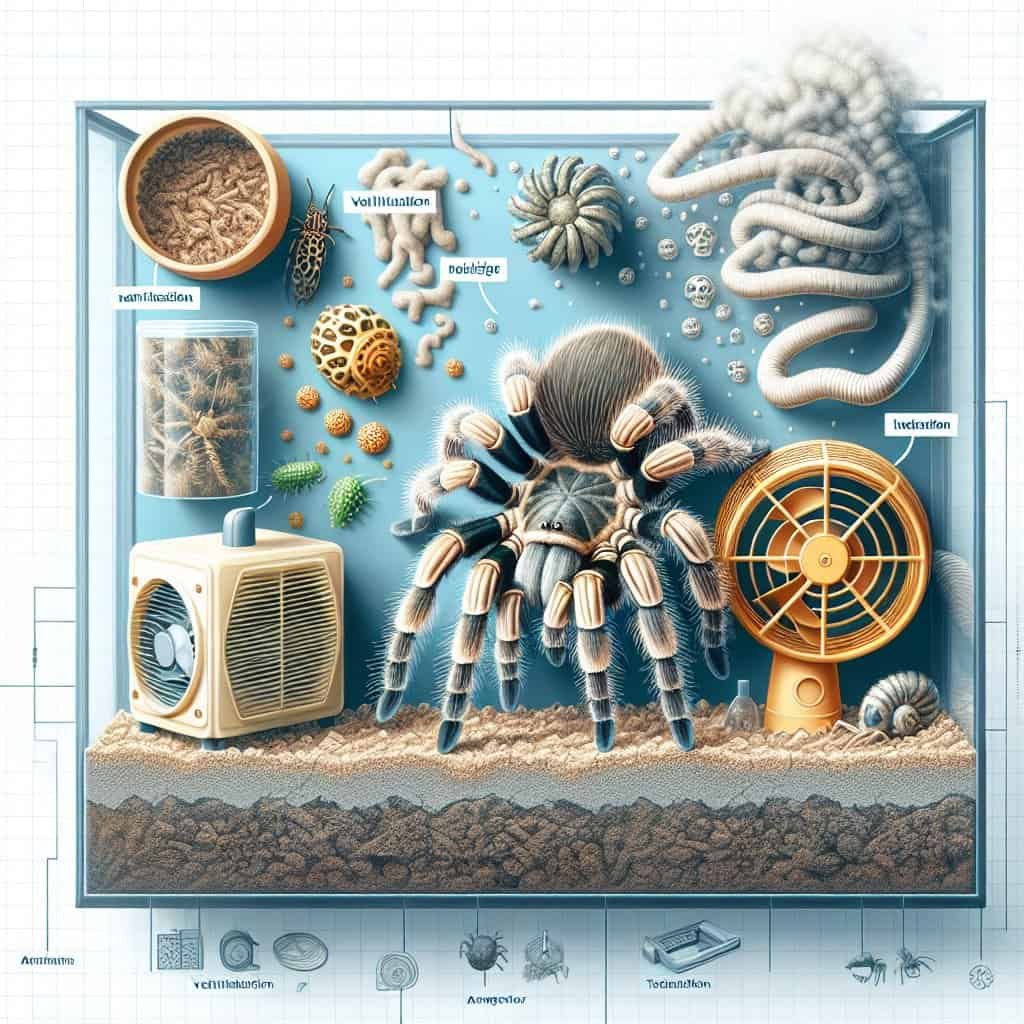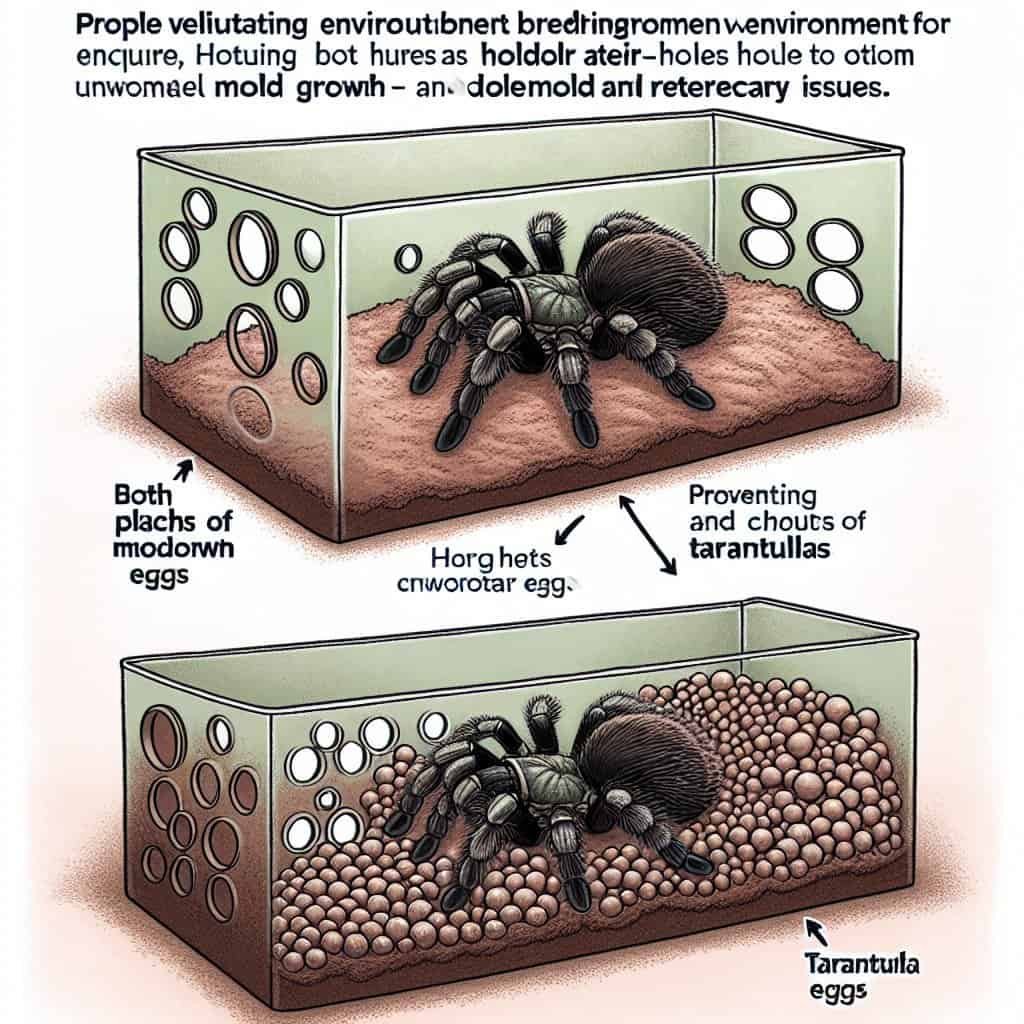Are you a tarantula enthusiast looking to breed these fascinating creatures in the comfort of your own home? If so, you may be wondering how to create a suitable environment for your tarantula breeding enclosure. One crucial aspect to consider is providing proper ventilation. In this article, we will explore different methods and techniques to ensure your tarantulas have the optimum airflow they need for successful breeding. So, let’s dive in and discover the secrets to achieving the perfect ventilation for your tarantula breeding enclosure!

Importance of Proper Ventilation
Maintaining Air Quality
Proper ventilation is crucial in a tarantula breeding enclosure to ensure the maintenance of air quality. Without adequate ventilation, the enclosure can quickly become stagnant, leading to a buildup of harmful gases, such as carbon dioxide and ammonia, which can be detrimental to the health of your tarantulas. By allowing fresh air to circulate, ventilation helps remove these gases and replenishes the oxygen levels, creating a healthy environment for your tarantulas to thrive.
Preventing Condensation
Another important aspect of proper ventilation is preventing condensation from occurring within the enclosure. Tarantulas require a certain level of humidity, but excessive moisture can lead to the development of condensation on the enclosure walls or the substrate, creating a breeding ground for bacteria and mold. Adequate ventilation helps in controlling moisture levels and preventing the formation of condensation, thus reducing the risk of respiratory problems and fungal infections among your tarantulas.
Regulating Temperature
Proper ventilation also plays a role in regulating the temperature within the tarantula breeding enclosure. Inadequate ventilation can result in poor air circulation, leading to temperature imbalances and hotspots. This can be particularly harmful to tarantulas, as they are sensitive to temperature fluctuations. By ensuring sufficient airflow, ventilation helps maintain a stable and comfortable temperature for your tarantulas, promoting their overall well-being.
Choosing the Right Enclosure
Consider Size and Structure
When selecting an enclosure for your tarantula breeding, it is essential to consider the size and structure. The enclosure should be large enough to accommodate the tarantulas comfortably, allowing them to move around and exhibit natural behaviors. A cramped space can hinder proper ventilation and create unfavorable conditions for breeding. Additionally, opt for an enclosure with adequate height, as tarantulas are known to climb, and this will enable better airflow within the enclosure.
Opt for Well-Ventilated Materials
The materials used in constructing the enclosure can significantly impact ventilation. It is advisable to choose materials that are well-ventilated, allowing for the passage of air through the enclosure walls. Glass or acrylic enclosures with ventilation holes or mesh lids are commonly used for tarantula breeding, as they provide the necessary airflow while still maintaining the required humidity levels. Avoid enclosures made of materials that are impermeable to air, such as solid wood or plastic, as they can impede proper ventilation.
Avoid Completely Sealed Containers
It is crucial to avoid using completely sealed containers for tarantula breeding enclosures. While airtight containers may seem suitable for maintaining humidity levels, they can quickly lead to poor ventilation. Without sufficient airflow, the enclosure can become stagnant, trapping waste gases and excess moisture. This can be detrimental to the health of your tarantulas and promote the growth of harmful bacteria. Choose enclosures that allow for proper ventilation while still providing the necessary humidity levels.

Positioning the Enclosure
Avoid Direct Sunlight
When positioning your tarantula breeding enclosure, it is essential to avoid placing it in direct sunlight. Direct sunlight can cause overheating, potentially leading to harmful temperature spikes within the enclosure. Excessive heat can be detrimental to tarantulas, as they require a stable and controlled temperature. Instead, choose a location that receives indirect sunlight or consider using curtains or blinds to regulate the amount of light entering the enclosure.
Place in a Well-Circulated Area
To ensure proper ventilation, it is crucial to position the tarantula breeding enclosure in a well-circulated area. Avoid placing the enclosure in a corner or an area with limited airflow. Instead, choose a location where air can freely circulate around the enclosure, promoting adequate ventilation. This may include placing the enclosure on a raised platform, away from walls or obstructions that could block airflow.
Consider Nearby Heat Sources
When deciding on the positioning of your tarantula breeding enclosure, take into account nearby heat sources. Avoid placing the enclosure near heaters, radiators, or other heat-emitting appliances. Heat sources can affect the temperature within the enclosure, potentially leading to imbalances and hotspots. By keeping the enclosure away from such sources, you can maintain a stable and consistent temperature, ensuring the well-being of your tarantulas.
Adding Ventilation Holes
Determining the Number and Size
Adding ventilation holes to the tarantula breeding enclosure is essential for proper airflow. The number and size of ventilation holes will depend on the size of the enclosure, the number of tarantulas housed within it, and the desired humidity levels. As a general guideline, ensure that there are enough ventilation holes to promote airflow without compromising the structural integrity of the enclosure. It is recommended to have multiple smaller holes rather than a few large ones, as this allows for more even distribution of airflow.
Location and Distribution
Strategic placement and distribution of ventilation holes are crucial for effective ventilation. Place the ventilation holes on different sides of the enclosure to encourage cross-ventilation. This helps prevent the formation of stagnant air pockets and promotes the circulation of fresh air throughout the enclosure. Additionally, ensure that the ventilation holes are not obstructed by decor, substrate, or other objects within the enclosure, as this can impede airflow.
Selecting Mesh or Perforations
The choice between mesh or perforations for ventilation holes depends on personal preference and the needs of your tarantulas. Mesh lids or screens are commonly used as they allow for adequate airflow while preventing escapes or the entry of unwanted pests. However, it is important to select a mesh size that is small enough to prevent the tarantulas from getting trapped or injured. Perforations, such as small drilled holes, can also be used to provide ventilation. Whichever option you choose, ensure that it allows for proper airflow while maintaining the necessary structural integrity of the enclosure.

Maintaining Humidity Levels
Monitoring Humidity
To ensure the well-being of your tarantulas, it is important to monitor and maintain appropriate humidity levels within the breeding enclosure. While proper ventilation helps control moisture levels, it is essential to regularly monitor the humidity using a hygrometer. This allows you to make adjustments as necessary to ensure the humidity falls within the recommended range for your specific tarantula species. Maintaining optimal humidity levels not only promotes healthy molting but also helps prevent respiratory issues and dehydration.
Using Appropriate Substrate
The choice of substrate can play a significant role in maintaining humidity levels within the tarantula breeding enclosure. Different tarantula species have varying substrate requirements, and selecting the appropriate substrate can help regulate moisture levels. Substrates such as coconut fiber, sphagnum moss, or a mixture of both retain moisture effectively and contribute to the overall humidity of the enclosure. However, it is important to strike a balance, as excessively damp substrate can lead to mold growth and respiratory problems for your tarantulas.
Avoiding Overly Dry or Humid Conditions
Maintaining a balance between humidity and airflow is crucial. While tarantulas require a certain level of humidity, it is equally important to avoid overly dry or humid conditions. Too much moisture can lead to condensation, mold growth, and respiratory issues, while excessively dry conditions can cause dehydration and difficulties during molting. Regularly monitor and adjust humidity levels based on the needs of your tarantulas and the specific requirements of the breeding process.
Using Safe Ventilation Accessories
Installing Air Circulation Fans
Air circulation fans can be beneficial in ensuring proper ventilation within the tarantula breeding enclosure. These fans help promote airflow and prevent the buildup of stagnant air pockets. However, it is important to select fans specifically designed for reptile or tarantula enclosures to ensure they meet the necessary safety standards. Install the fans in a way that allows for optimal airflow without causing disturbances or stress to your tarantulas.
Choosing Suitable Ventilation Devices
Apart from air circulation fans, there are various other ventilation devices available that can aid in maintaining proper airflow within the breeding enclosure. These include ventilation grilles, heat vents, or even specialized enclosures with built-in ventilation systems. When selecting such devices, it is essential to consider the specific needs of your tarantulas, the size of the enclosure, and the overall functionality and durability of the ventilation system.
Avoiding Hazards and Entrapment
When using ventilation accessories, it is crucial to prioritize the safety of your tarantulas. Avoid using devices with large openings or grilles that could allow tarantulas to escape or become trapped. Opt for accessories that have been specifically designed for tarantula enclosures to minimize the risk of injury or harm to your tarantulas. Regularly inspect and clean ventilation devices to ensure they are functioning properly and free from blockages.

Cleaning and Maintaining Ventilation
Regular Dusting and Inspection
Proper ventilation requires regular cleaning and maintenance to ensure optimal airflow. Dust and debris can accumulate in ventilation holes or on mesh lids, obstructing airflow and compromising the effectiveness of ventilation. Regularly dust the ventilation holes and inspect the mesh or perforations for any signs of blockage or damage. Cleaning can be done using a soft brush or a cotton swab, ensuring that you do not disturb or harm your tarantulas in the process.
Preventing Blockages
In addition to regular dusting, it is important to take preventive measures to avoid blockages in the ventilation holes. Monitor the enclosure for any loose substrate, debris, or shed skin that may accumulate near the ventilation holes. These can potentially clog the holes and impede the airflow. Keep the area around the ventilation holes clean and clear of any obstructions to ensure unrestricted ventilation for your tarantulas.
Replacing or Repairing Damaged Vents
If your tarantula breeding enclosure has damaged or broken ventilation vents, it is crucial to replace or repair them promptly. Broken vents not only compromise ventilation but also pose a potential hazard to the tarantulas, as they may attempt to escape through the damaged area. Regularly inspect the ventilation vents for signs of damage, such as cracks or gaps, and take appropriate measures to rectify any issues to maintain proper ventilation within the enclosure.
Ventilation Measures during Breeding
Separating Male and Female Enclosures
During the breeding process, it is important to consider ventilation measures specific to male and female tarantulas. It is advisable to separate the male and female tarantulas into individual enclosures to avoid potential conflicts and ensure the safety of the male after mating. Each enclosure should have adequate ventilation to maintain optimal conditions for the tarantulas during this critical period.
Ensuring Proper Air Exchange
Proper air exchange is crucial during the breeding process to maintain ventilation and prevent the buildup of gas or chemicals. Ensure that both the male and female enclosures have sufficient ventilation to allow for fresh air intake and the removal of waste gases. Proper ventilation not only supports the well-being of the tarantulas but can also contribute to successful breeding outcomes.
Preventing Fungal Growth
During the breeding process, the humidity levels within the tarantula breeding enclosures may need to be adjusted to facilitate breeding behaviors and egg-laying. However, it is important to monitor the humidity closely and take measures to prevent fungal growth. Adequate ventilation in the enclosures helps control moisture levels, reducing the risk of fungal infections that can be harmful to the eggs or the tarantulas. Regularly inspect the enclosure for any signs of fungal growth and promptly address the issue to prevent further spread.

Monitoring and Responding to Signs of Poor Ventilation
Recognizing Symptoms of Inadequate Ventilation
It is crucial to monitor your tarantulas for any signs of poor ventilation within the breeding enclosure. Symptoms of inadequate ventilation may include increased respiratory issues, restlessness, decreased appetite, or unusual behaviors. If you notice any of these signs, it is important to assess the ventilation of the enclosure and take appropriate measures to improve airflow and air quality.
Addressing Excessive Moisture or Odor
Excessive moisture or unpleasant odors within the tarantula breeding enclosure can be indicative of poor ventilation. If you notice a strong odor or consistently high humidity levels, it is crucial to assess the ventilation system. Check for any blockages or damage to the ventilation holes, as these can hinder proper airflow. Additionally, ensure that the enclosure is not excessively damp, as this can lead to fungal growth. Take immediate action to address any issues and improve ventilation to maintain a healthy environment for your tarantulas.
Consulting a Tarantula Breeding Expert
If you are unsure of how to properly assess and improve ventilation within your tarantula breeding enclosure, it is advisable to seek professional advice from a tarantula breeding expert. These experts have the knowledge and experience to guide you on the specific requirements of your tarantula species and provide personalized recommendations for ventilation improvements. Additionally, consider joining online communities or attending reptile expos and workshops to learn from experienced tarantula breeders and gain valuable insights into proper ventilation practices.
Consulting a Tarantula Breeding Expert
Seeking Professional Advice
When it comes to providing proper ventilation in a tarantula breeding enclosure, it is always beneficial to consult a tarantula breeding expert. These experts have extensive knowledge and experience in tarantula care and can provide personalized advice tailored to your specific breeding setup. By seeking professional advice, you can ensure that you are creating the best possible environment for your tarantulas to thrive.
Joining Online Communities
Another valuable resource for information and guidance on providing proper ventilation in tarantula breeding enclosures is online communities. There are numerous forums and social media groups dedicated to tarantula enthusiasts and breeders. Joining these communities allows you to connect with like-minded individuals who can share their experiences and expertise. You can ask questions, seek advice, and gain insights into best practices for proper ventilation in tarantula breeding enclosures.
Attending Reptile Expos and Workshops
Lastly, attending reptile expos and workshops can be an excellent opportunity to learn from experts in person. These events often feature seminars or workshops conducted by experienced tarantula breeders, providing valuable insights and practical demonstrations on various aspects of tarantula care, including ventilation. Additionally, you can network with fellow enthusiasts, exchange knowledge, and stay updated on the latest trends and advancements in tarantula breeding.
In conclusion, providing proper ventilation in a tarantula breeding enclosure is essential for maintaining air quality, preventing condensation, regulating temperature, and ensuring the overall health and well-being of your tarantulas. By choosing the right enclosure, positioning it correctly, adding ventilation holes, maintaining humidity levels, using safe ventilation accessories, and regularly cleaning and maintaining the ventilation system, you can create a conducive environment for successful tarantula breeding. Additionally, monitoring and responding to signs of poor ventilation and consulting tarantula breeding experts or joining online communities can provide valuable guidance and support in optimizing the ventilation in your tarantula breeding enclosure.
